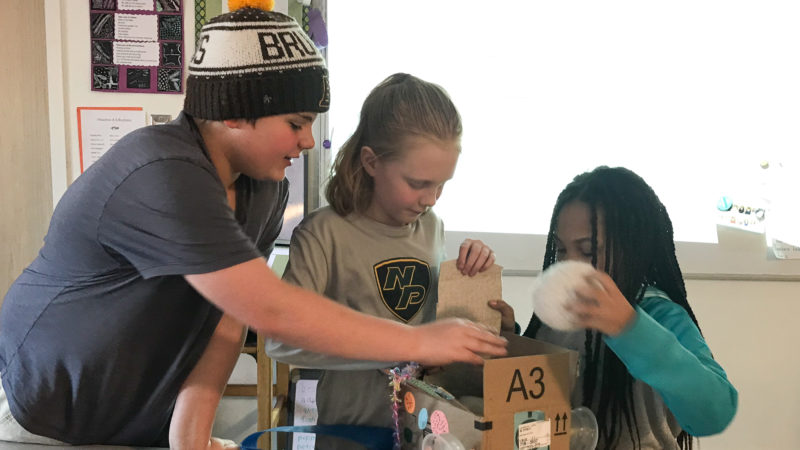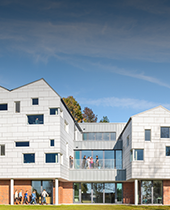Novel Engineering in the Lower School
Students in Waynflete’s 4-5 program engage in design thinking
How can Peter keep his snowball from melting? What will Nanette do to resist eating the baguette on the way home from the store? How will Mr. McGreely stop rabbits from eating his garden vegetables? Inspired by the characters in Ezra Jack Keats’s The Snowy Day, Mo Willems’s Nanette’s Baguette, and Candace Fleming and G. Brian Karas’s Muncha! Muncha! Muncha!, students in Waynflete’s 4-5 program recently immersed themselves in the “design thinking” methodology.
 Design thinking emerged as a concept in the 1950s when strategists began to formalize a series of repeatable stages that would allow a team to reach the best solution based on group skills and available resources. The process was later adapted for business settings by IDEO founder David M. Kelley. Design thinking begins with empathy: putting yourself in the shoes of people, organizations, or—in the case of 4-5 students—book characters who are experiencing a problem. As Kelley writes in his book, Creative Thinking, empathy is the foundation of innovative design, allowing teams to more accurately define the problem. Ideation follows, with team members calling on their individual skills and passions to brainstorm potential solutions. Teams then develop prototypes or models. Finally, teams solicit feedback from others during the final testing stage, making revisions where necessary.
Design thinking emerged as a concept in the 1950s when strategists began to formalize a series of repeatable stages that would allow a team to reach the best solution based on group skills and available resources. The process was later adapted for business settings by IDEO founder David M. Kelley. Design thinking begins with empathy: putting yourself in the shoes of people, organizations, or—in the case of 4-5 students—book characters who are experiencing a problem. As Kelley writes in his book, Creative Thinking, empathy is the foundation of innovative design, allowing teams to more accurately define the problem. Ideation follows, with team members calling on their individual skills and passions to brainstorm potential solutions. Teams then develop prototypes or models. Finally, teams solicit feedback from others during the final testing stage, making revisions where necessary.
Tufts University adapted the design thinking protocol for elementary schools through its “Novel Engineering” program, which reinforces literacy skills by asking students to engage deeply with narratives by empathizing with characters’ problems. Picture books are exceptional vehicles for introducing the design thinking process to younger students— they show, in a succinct way, the basic problem/solution structure of a story, and the development of the books’ characters as the plot progresses.
 With help from Lower School Librarian Laurel Daly, students in the 4-5 program began by considering the word “novel”—its two meanings (a book, and a new experience) and how both meanings applied to the project. As they explored illustrations and text, students used visual thinking strategies to gain empathy for the books’ characters. Nanette’s facial and body expressions, for example, made it clear how much she struggled with resisting the warm, wonderful baguette, and how devastated she was when she couldn’t. The students could relate to those emotions.
With help from Lower School Librarian Laurel Daly, students in the 4-5 program began by considering the word “novel”—its two meanings (a book, and a new experience) and how both meanings applied to the project. As they explored illustrations and text, students used visual thinking strategies to gain empathy for the books’ characters. Nanette’s facial and body expressions, for example, made it clear how much she struggled with resisting the warm, wonderful baguette, and how devastated she was when she couldn’t. The students could relate to those emotions.
After defining the problems that the characters were experiencing, group members brainstormed a list of possible solutions. They chose one approach to develop as a prototype that they would build with reusable materials, including egg cartons, plastic straws, cardboard, and yogurt containers. Students tested their prototypes, shared them with others, and incorporated revisions based on feedback.
 Lower School Director Anne Hopkins contends that design thinking is an educational imperative. “Children today want instantaneous answers,” she says. “But learning is still about revising and revising again, in a collaborative way. We have no idea what kind of problems today’s students will be tackling when they enter the workforce. But we do know that they’ll have to be able to work effectively with communities of people.”
As students move on to Waynflete’s middle and upper schools, they use more complex tools to address more abstract problems that they encounter. Programmable Legos become coding languages; the challenge might be to test a geometry proof or evaluate a chemical reaction.
Lower School Director Anne Hopkins contends that design thinking is an educational imperative. “Children today want instantaneous answers,” she says. “But learning is still about revising and revising again, in a collaborative way. We have no idea what kind of problems today’s students will be tackling when they enter the workforce. But we do know that they’ll have to be able to work effectively with communities of people.”
As students move on to Waynflete’s middle and upper schools, they use more complex tools to address more abstract problems that they encounter. Programmable Legos become coding languages; the challenge might be to test a geometry proof or evaluate a chemical reaction.
 Design thinking accommodates all kinds of learners and personality types. The challenge for a “go-getter”-type student, for example, might be to embrace other children’s ideas and contributions. Some students may prefer to research facts and obtain data, while others might prefer, as Anne says, “to dress up as a light switch as part of a skit on the importance of turning off the lights.”
Design thinking accommodates all kinds of learners and personality types. The challenge for a “go-getter”-type student, for example, might be to embrace other children’s ideas and contributions. Some students may prefer to research facts and obtain data, while others might prefer, as Anne says, “to dress up as a light switch as part of a skit on the importance of turning off the lights.”
With the Lower School’s emphasis on an emergent curriculum, Waynflete teachers are already well-positioned to show children how they can be agents in bringing about change. “Things can go awry during the experimentation phase of the design thinking protocol, but that’s part of the process,” says Anne. “We can set up comfortable boundaries while embracing the remarkable things that kids can come up with on their own. There is no ‘single path’ that teachers must show their students.”
 Kids love the design thinking protocol. They relish being given a new kind of freedom to explore and fully exercise their creativity, whether it be in building, in design, or just thinking up outrageous ideas. “When students are engaged in design thinking, the energy in the room is palpable. We discovered that the groups wanted to keep working on their prototypes in their own time, during recess,” says Anne. “We said to them, ‘You want to keep going? Go ahead! There’s nothing stopping you!’ I believe that if we give kids the opportunity to find their own solutions to real-life problems—and get out of their way when it’s appropriate—they will be well-poised to continue doing so in the world.”
Kids love the design thinking protocol. They relish being given a new kind of freedom to explore and fully exercise their creativity, whether it be in building, in design, or just thinking up outrageous ideas. “When students are engaged in design thinking, the energy in the room is palpable. We discovered that the groups wanted to keep working on their prototypes in their own time, during recess,” says Anne. “We said to them, ‘You want to keep going? Go ahead! There’s nothing stopping you!’ I believe that if we give kids the opportunity to find their own solutions to real-life problems—and get out of their way when it’s appropriate—they will be well-poised to continue doing so in the world.”
Read about Tufts University’s “Novel Engineering” program.




